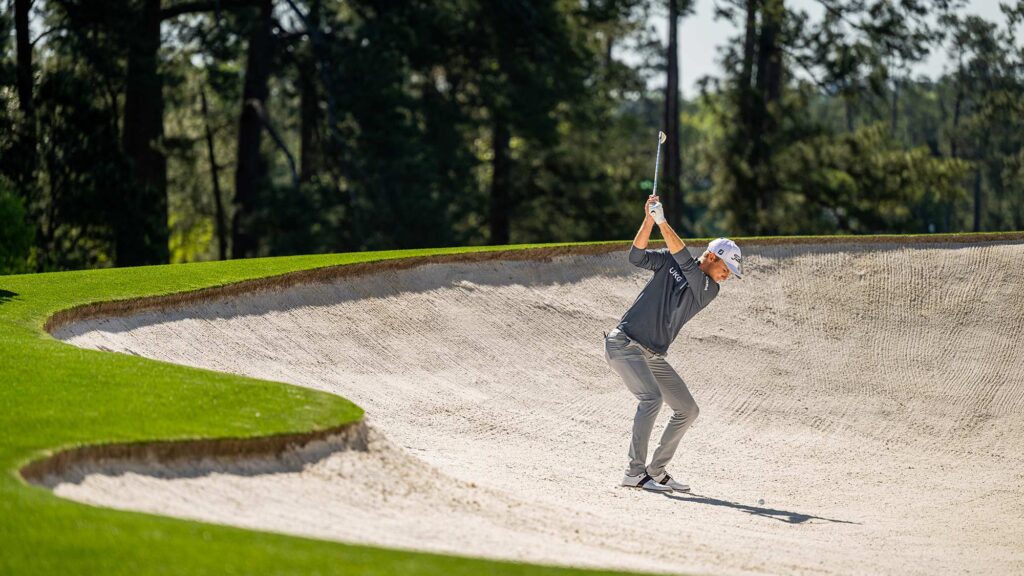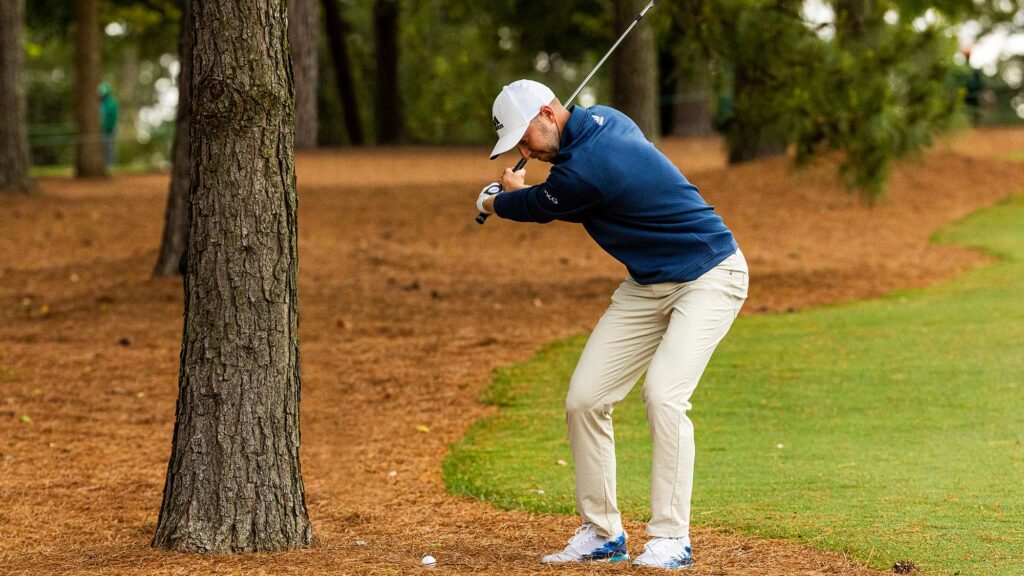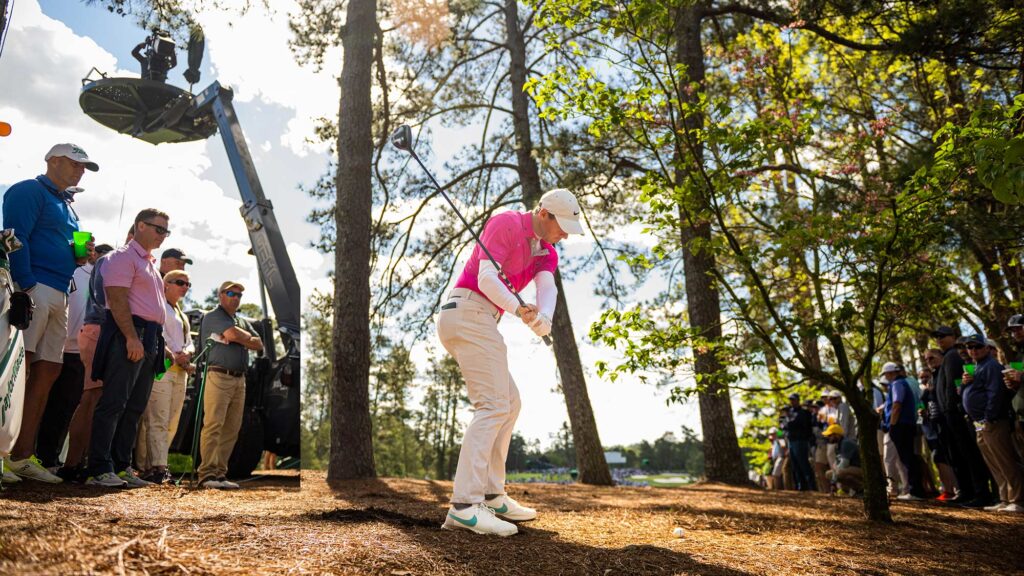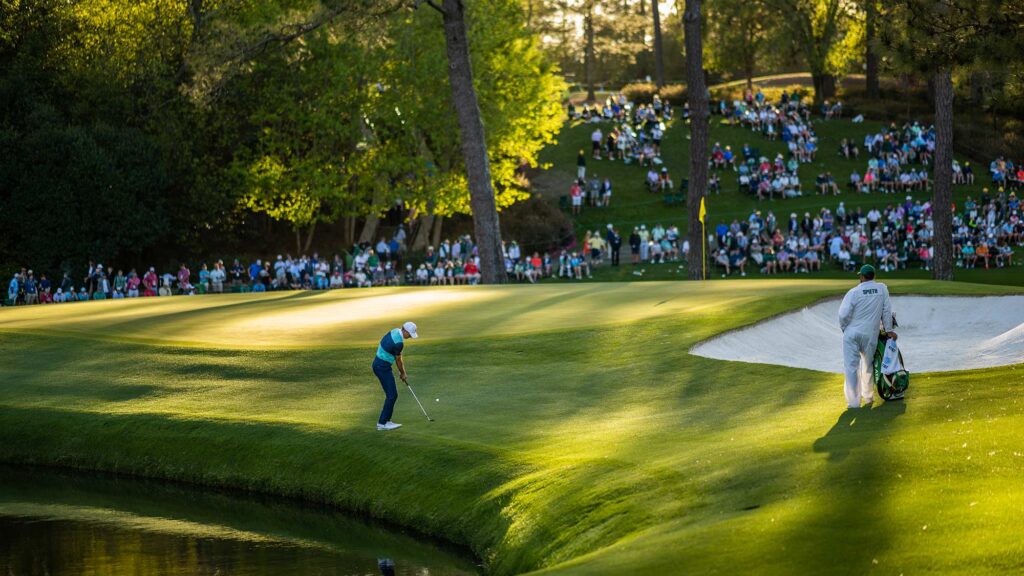What you can learn from how the Pros play these shots at Augusta.
Featured photo by J.D. Cuban
What they say about Augusta National is true – Television doesn’t do the property justice. I’m not just talking about the beauty of the place; I also mean the terrain. If you’ve never been there, you can’t truly appreciate how hilly and undulating the golf course is. even in the fairway you can find your ball in a tough lie!
Most weekend golfers don’t practise on anything but flat, stable surfaces, so watching the masters is a good time to revisit the fundamentals of how to play from various awkward lies. Starting with that great photo of Tiger Woods hitting from the pinestraw on the previous pages, let’s look at some of the game’s best players from last year’s Masters and break down how they played shots from these difficult positions. Remember the key points, and these shots won’t seem so unnerving the next time you encounter them.
UNSTABLE-GROUND LIE: DIG IN, STAY QUIET
Tiger can make any trouble shot look easy, so his play from the pinestraw on the fifth hole probably wasn’t as tough as playing from a similar lie might be for you. The first thing is to note that it’s kind of like playing off pick-up sticks. If you get too close, the pinestraw you move could force more pinestraw to move and possibly the ball. Remember to approach with caution.
Whenever you’re playing off an unstable surface – not just pinestraw – set up with your feet feeling “dug in”. Pinestraw is slippery, so get your balance from the start. A wider stance helps, too. When you swing, keep your footwork to a minimum to ensure good contact. This is not a place where you want to go 100 percent. Back down your effort. Notice how Tiger even gripped down on his iron for better control.
Although unrelated to playing in pinestraw, this “hold off” look that Tiger has at the end of his swing shows he was trying to shape the ball left to right. What that should tell you is that it’s possible to curve a shot from this lie and possibly knock it on the green. But your priority should be getting the ball back in play. Advance it and take your chance at an up-and-down save.

SIDEHILL BUNKER LIE: KEEP THE FLEX IN YOUR KNEES
Will Zalatoris knocked his tee shot into this huge bunker on the par-5 second hole and found himself having to play from a tough lie [above]. Just like when you have a downhill-sidehill lie on firm turf,
this is one of the most challenging scenarios for amateurs to get good contact.
With any uneven lie, you’ve got to set your body so it matches the angle of the slope. In this instance,
Will probably set up feeling more weight on his left side with his left shoulder lower than it normally would be at address. A downslope shot is hard enough, but the addition of sideslope means the ball is below your feet. To make sure gravity doesn’t pull you in the direction of the ball, it’s smart to stand a little wider and add more knee flex like you see Will doing here.
The last thing to remember is that you can’t lose that exaggerated flex when you swing. What happens is that players come out of this stance fairly often as they swing down, usually thinking they need to help the ball over the lip. That’s a mistake. If you keep your angles and finish in a somewhat restricted follow-through, you’ll give yourself the best chance of a good strike.

DOWNHILL-SIDEHILL LIE: CHASE AFTER THE BALL
Unlike the downhill-sidehill lie Will Zalatoris had, Cam Smith’s lie on the ninth fairway poses a different kind of issue at setup. Namely, you can’t dig in with your feet to make sure you keep your balance when you swing. You have to stand a little wider for better stability. Another setup key is to feel like you’re a little lower to the ground, almost like you’re about to sit down on a stool. Keep that “low” feeling when you swing.
This uneven lie is going to encourage you to swing down on a steeper angle than normal, which is why I often use it as an effective teaching aid for players who have a backswing that’s too flat. When you do swing down on more of an upright angle, be sure to marry that with this great swing thought: chase the ball down the hill with the clubhead.
Hitting down the slope is going to produce the best result, even to the point where you could actually walk down the fairway after the shot. One more thing to remember: the ball will tend to fly lower and move left to right for righties and right to left for lefties, so adjust your aim and club selection.

ABBREVIATED-SWING LIE: STRIP DOWN YOUR ACTION
Whenever a tree or some other immovable object is too close and you fear you might strike it, it’s going to have a psychological effect on how you play the ball. It looks like Daniel Berger had enough clearance from this tree on the ninth hole to make somewhat of a normal swing, but a lefty wouldn’t have been as fortunate.
When facing a lie where you have to manufacture some sort of abbreviated swing to advance the ball, or the lie is suspect as it is here for Daniel, you’ve got to strip down your swing to ensure you hit the ball solidly. Footwork is the first thing to adjust: your lower body should feel like it’s relatively quiet throughout the swing, like you’re flat-footed. You also can see that Daniel has gripped down on the club quite a bit. That’s also an adjustment for more control.
Other things to consider are to take an extra club and swing at less-than-full pace. Again, all of this is to make sure you hit it as cleanly as you can. Daniel appears to be making a steep downswing into the ball, and he’s playing it farther back in his stance than normal. Both of those adjustments will help you get ball-first contact – anything less than that and the shot will go nowhere.

IN-JAIL LIE: AIM SMALL
There’s a lot going on in this photo of Rory McIlroy trying to knock it down towards the second green with a fairway wood [above]. What I want to focus on is the escape aspect of his play. You’ve probably encountered opportunities where not only can you get the ball back in play, you also can pick up some distance. It comes with a catch, however. You’ve got to put the ball through a “window”, and if you miss that opening, you’re probably playing your next shot from a worse spot than you’re currently in.
So how do the pros make these thread-the-needle shots look so easy? For starters, their swing thought isn’t, Don’t hit the tree. Players like Rory are very conscious of their shot’s starting point. They see it beforehand and commit to making it happen.
The mistake you might make is to try to guide the ball through the opening. You have to instead select a very small window, and then make a full swing that isn’t steery in appearance. Don’t look up too quickly. Finish the swing. One more thought: try picturing a bullseye between the obstacles in front of you and put all your focus on it, not where you don’t want the ball to go.

UPHILL-SIDEHILL FAIRWAY LIE: CLUB UP AND GRIP DOWN
If you love watching the Masters, you’re more than familiar with the lie Scottie Scheffler has on the dogleg-left, par-5 13th hole [above]. When the ball is above your feet, the first thing to consider is your aim. You will probably draw or hook the ball from this lie, so righties should aim right of where they want the ball to end up and lefties should aim left.
When the ball is above your feet at address, it’s wise to grip down on your club a little or you risk hitting it fat. Also, take an extra club because the terrain is going to produce a higher, softer shot than if you were standing on flat turf. The other setup adjustment is to make sure your body is perpendicular to the upslope.
When you swing, keep in mind that it will be difficult to shift your weight towards the target. You’ll feel like you’re favouring your back foot, so an abbreviated motion will help you avoid swaying off the ball.

OFF-BALANCE CHIPPING LIE: SIMULATE IT FIRST
Around the greens you sometimes have to make adjustments to your stance and swing to get the ball on the putting surface. That was nearly the case for Jordan Spieth on the par-5 15th where he had to play from a steep bank next to the hole’s famous pond [above]. Jordan was lucky that he didn’t have to stand with his right foot way lower than his left, but it’s worth discussing what to do when one foot is dramatically higher than the other.
Getting your feet in a position where you feel balanced is important, but so is trying to simulate the shot you’re about to hit. Experiment with different stances, trying to identify the one that feels most comfortable. When you have it, step away from the ball, find a spot where you can closely recreate the scenario, then make practice swings to get a feel for the shot. Now step back in and hit the shot with this newfound familiarity. Jordan’s not trying to do anything fancy here; nor should you. Take your chances that your putter can bail you out rather than going for the hero short-game shot.



